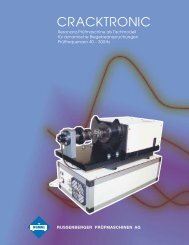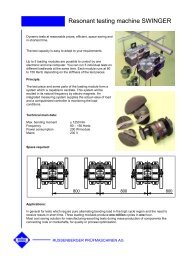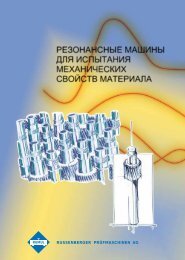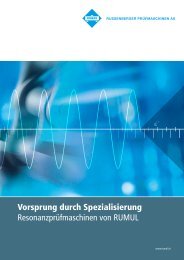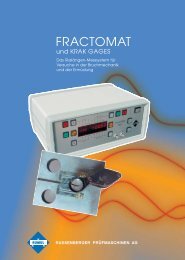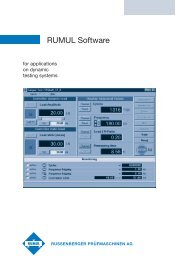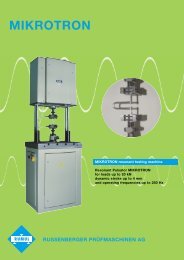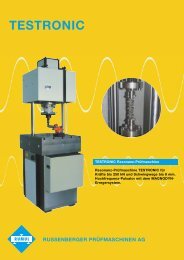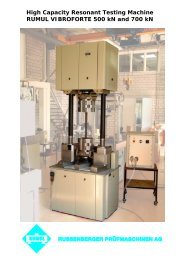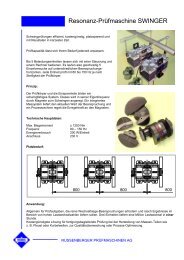RUMUL resonant fatigue testing machines - Russenberger ...
RUMUL resonant fatigue testing machines - Russenberger ...
RUMUL resonant fatigue testing machines - Russenberger ...
You also want an ePaper? Increase the reach of your titles
YUMPU automatically turns print PDFs into web optimized ePapers that Google loves.
Leading through specialization<br />
<strong>RUMUL</strong> <strong>resonant</strong> <strong>fatigue</strong> <strong>testing</strong> <strong>machines</strong><br />
www.rumul.ch
HISTORY<br />
<strong>RUMUL</strong> VIBROPHORE<br />
sketch dated 1938<br />
1938<br />
<strong>RUMUL</strong> VIBROPHORE concept<br />
www.rumul.ch<br />
<strong>RUMUL</strong> – Pioneers<br />
in <strong>resonant</strong> <strong>fatigue</strong> <strong>testing</strong>.<br />
A dynamic success story.<br />
In the end of the thirties of the last century<br />
Max E. <strong>Russenberger</strong> had his first contacts<br />
to the <strong>testing</strong> technology at Alfred J.<br />
Amsler & Co. who where at that time wellestablished<br />
manufacturers of <strong>resonant</strong><br />
<strong>testing</strong> <strong>machines</strong>.<br />
The young engineer was thrilled by all aspects of<br />
technology, therefore, it was not really surprising<br />
that he was very successfully attributing to many<br />
inventions with new and unconventional ideas<br />
and solutions.<br />
He world-wide gained recognition with his<br />
contributions to the field of <strong>resonant</strong> <strong>fatigue</strong><br />
<strong>testing</strong> technology.<br />
In 1964 Max E. <strong>Russenberger</strong> founded his own<br />
business and Erwin Müller joined him soon as a<br />
partner. The short name <strong>RUMUL</strong> dates back to<br />
this partnership. The particular talents in inventing<br />
lead to completely new designed <strong>resonant</strong> <strong>testing</strong><br />
<strong>machines</strong>.<br />
In 1978 Roland Berchtold joined the company.<br />
His passion for <strong>resonant</strong> <strong>testing</strong> technology and<br />
more than 12 years of team work with Max E.<br />
<strong>Russenberger</strong> resulted in the development of<br />
a new oscillating system consisting of masses<br />
1964<br />
company foundation <strong>RUMUL</strong><br />
and springs which was suitable for many new<br />
applications as well as for the smallest as for the<br />
biggest <strong>testing</strong> <strong>machines</strong>. Also he was the first<br />
to introduce computer technology to the field of<br />
<strong>resonant</strong> <strong>testing</strong>.<br />
In 1989 the company moved into new and larger<br />
premises in Neuhausen on the Rhine Falls.<br />
In 1995 Jürg Berchtold, Roland Berchtold’s<br />
son, joined the company after his graduation in<br />
engineering and several stays abroad.<br />
In the year 2005 a fully digital state-of-the art<br />
controller for <strong>resonant</strong> <strong>testing</strong> <strong>machines</strong> directed<br />
by Jürg Berchtold was introduced to the market<br />
with great success. In the same year the innovative<br />
high capacity <strong>resonant</strong> <strong>testing</strong> machine<br />
<strong>RUMUL</strong> VIBROFORTE was developed.<br />
In 2008 Roland Berchtold transferred the operational<br />
management to his son Jürg Berchtold.<br />
Roland Berchtold continues to support <strong>RUMUL</strong> as<br />
president of the board of directors and as senior<br />
technical consultant.<br />
With the new software generation based on the<br />
approved and widespread LabVIEW surrounding<br />
<strong>RUMUL</strong> set in 2010 a new benchmark in <strong>resonant</strong><br />
<strong>fatigue</strong> <strong>testing</strong>.<br />
1970<br />
<strong>resonant</strong> <strong>testing</strong> machine<br />
<strong>RUMUL</strong> TESTRONIC 7001<br />
up to 200 kN<br />
1982<br />
compact table model<br />
<strong>RUMUL</strong> CRACKTRONIC<br />
2
The company<br />
<strong>RUMUL</strong> <strong>Russenberger</strong><br />
Prüfmaschinen AG,<br />
Neuhausen am Rheinfall,<br />
Switzerland<br />
Max E. <strong>Russenberger</strong><br />
Founder of the company<br />
<strong>RUMUL</strong><br />
Jürg Berchtold<br />
Managing Director<br />
1986<br />
<strong>RUMUL</strong> TESTRONIC with<br />
new original dynamic drive<br />
„<strong>RUMUL</strong> MAGNODYN“<br />
up to 250 kN<br />
3<br />
Roland Berchtold<br />
President of the Board of<br />
Directors<br />
Ingbert Klopfer<br />
Sales Manager<br />
1992<br />
<strong>RUMUL</strong> MIKROTRON<br />
5 kN and 20 kN new<br />
generation with t-slotted<br />
table for component <strong>testing</strong><br />
The philosophy of the company<br />
reads:<br />
u simple concepts<br />
u application and user oriented solutions<br />
u fair partnership with our customers<br />
These principles, our concentration to the<br />
<strong>resonant</strong> <strong>testing</strong> technology as well as the<br />
increased demand for fast and at the same<br />
time energy saving and non-polluting<br />
<strong>testing</strong> systems ensure that we will remain<br />
your reliable, innovative and qualified<br />
partner in the future.<br />
2000<br />
certification<br />
according to<br />
ISO 9001<br />
2005<br />
fully digital controller<br />
<strong>RUMUL</strong> TOPP and high<br />
capacity <strong>testing</strong> machine<br />
<strong>RUMUL</strong> VIBROFORTE<br />
500 kN<br />
Resonant Fatigue<br />
Testing = <strong>RUMUL</strong><br />
2010<br />
<strong>RUMUL</strong> Software<br />
based on LabVIEW
Working principle and applications<br />
Two-Mass-Oscillating-System<br />
(simplified)<br />
1 Fastener <strong>fatigue</strong> test<br />
2 Chain <strong>fatigue</strong> test<br />
3 Rebar <strong>fatigue</strong> test<br />
4 Precracked CT-samples<br />
www.rumul.ch<br />
Save time and money<br />
with <strong>RUMUL</strong> <strong>resonant</strong> <strong>fatigue</strong><br />
<strong>testing</strong> <strong>machines</strong><br />
With a <strong>resonant</strong> <strong>testing</strong> machine dynamic<br />
loads can be applied to specimens and<br />
components, which in in most cases are<br />
superimposed by a static load.<br />
The static load is generated by a maintenance free<br />
servo motor, the dynamic load by a maintenance<br />
free oscillating system (resonator) oscillating in its<br />
natural frequency. The oscillating system consists<br />
of masses and springs, the specimen itself being<br />
part of this oscillating system.<br />
<strong>RUMUL</strong> <strong>resonant</strong> <strong>testing</strong> <strong>machines</strong> work at full<br />
resonance, i.e. the operating point is situated on<br />
the top of the resonance curve, achieving thus a<br />
very high amplification of the applied excitation<br />
load.<br />
A correspondingly controlled and excited electromagnet<br />
supplies as much energy to the oscillating<br />
system to reach and maintain the oscillating<br />
amplitude. Due to the <strong>resonant</strong> effect the power<br />
consumption and thus the running costs are very<br />
low (only approx. 1 % to 2 % in comparison to<br />
servo hydraulic <strong>testing</strong> systems).<br />
The construction of the different oscillating<br />
systems allows very high test frequencies (approx.<br />
40 Hz – 260 Hz) resulting in very short test times.<br />
According to type of specimen, test load and<br />
activated masses the test times may by reduced<br />
by the coefficient 2 to 20 in comparison to servo<br />
hydraulic test systems.<br />
1 2 3 4<br />
4
High test frequencies<br />
at extremely low running costs<br />
The most common applications for <strong>resonant</strong><br />
<strong>testing</strong> <strong>machines</strong> are <strong>fatigue</strong> tests (S/N<br />
curves) on specimens and more and more<br />
on components in the High Cycle Fatigue<br />
(HCF) and Very High Cycle Fatigue (VHCF)<br />
range.<br />
These tests may be run under ambient temperature<br />
or using special equipment under<br />
environmental simulation conditions (temperature,<br />
corrosion etc). With the software module block<br />
program block tests and blocked random tests can<br />
be executed.<br />
5<br />
1 Temperature chamber<br />
2 Furnace <strong>RUMUL</strong> THERMOTRON<br />
In the range of fracture mechanics tests fast<br />
and economic precracking tests (generating of<br />
a <strong>fatigue</strong> crack) are possible by means of the<br />
frequency drop detection without the need of<br />
using crack length measurement systems.<br />
Fatigue crack growth tests and the determination<br />
of the ΔK-Threshold value on fracture mechanics<br />
specimens is a further application range where<br />
<strong>RUMUL</strong> has more than 25 years of experience<br />
and where the advantages of fast and economic<br />
tests with <strong>resonant</strong> <strong>testing</strong> <strong>machines</strong> satisfy our<br />
customers.<br />
1 2
Solutions for lower load levels<br />
CRACKTRONIC<br />
Module Arrangements<br />
1 Torsion module<br />
2 CT-module<br />
3 Customized<br />
module for valve<br />
needles<br />
www.rumul.ch<br />
<strong>RUMUL</strong> CRACKTRONIC<br />
Our little one with the smart rotary drive<br />
The <strong>RUMUL</strong> CRACKTRONIC is our table<br />
model combining minimum weight and<br />
low space requirement for fast dynamic<br />
bending load applications at low cost up to<br />
a bending moment of 160 Nm.<br />
An electromagnetic driven resonator, built as<br />
a rotary oscillator, creates an appropriate pure<br />
bending moment. A static moment can be applied<br />
to the specimen independent from the dynamic<br />
drive by the use of a torsion rod.<br />
Originally designed for the precracking of fracture<br />
mechanics specimens today’s modular concept<br />
offers the following test possibilities:<br />
1 2 3<br />
Test loads up to 8 kN · 160 Nm · table top model<br />
Bending up to 160 Nm, torsion up to 160 Nm and<br />
tension up to 8 kN.<br />
Besides the standard modules there are customer<br />
specific special modules available for the <strong>testing</strong> of<br />
small components such as valve needles, injection<br />
valves etc.<br />
The test frequency ranges from 40 Hz to 250 Hz<br />
depending on type of specimen, test module and<br />
activated masses and can be adjusted in 6 steps.<br />
Due to the very compact construction the<br />
<strong>RUMUL</strong> CRACKTRONIC is especially suited for<br />
the use in the nuclear industry in «hot cells» for<br />
precracking of contaminated small CT, Charpy and<br />
Mini Charpy specimens.<br />
6
<strong>RUMUL</strong> MIKROTRON<br />
Our most universal lightweight<br />
The <strong>RUMUL</strong> MIKROTRON is the smaller and<br />
more compact execution of the <strong>RUMUL</strong><br />
TESTRONIC for loads up to 5 kN resp. up to<br />
20 kN and – if necessary – for higher<br />
dynamic stroke values.<br />
7<br />
1 3-point-bending device<br />
2 4-point-bending device<br />
3 Torsion device<br />
The main feature of this construction is the<br />
big stroke of the oscillating mass leading to a<br />
particularly low total weight for a <strong>resonant</strong> <strong>testing</strong><br />
machine (only approx. 30 % in comparison with<br />
similar <strong>testing</strong> systems). Thanks to the t-slotted<br />
machine table the range of applications is<br />
extended to the more and more required <strong>testing</strong><br />
of components. Due to the control unit being<br />
located in the load frame the <strong>RUMUL</strong> MIKROTRON<br />
is a very compact and thus space saving <strong>testing</strong><br />
solution.<br />
The operating frequency ranges from 40 Hz<br />
to 250 Hz depending on specimen stiffness<br />
and activated masses of the oscillating system<br />
(adjustable in 4 resp. 5 steps).<br />
Test loads up to 5 | 20 kN · stand alone<br />
1 2 3<br />
<strong>RUMUL</strong> HydroGrip with joining<br />
technology test sample<br />
<strong>RUMUL</strong> MIKROTRON<br />
lightweight, universal<br />
and fast
Fast <strong>fatigue</strong> <strong>testing</strong> at high test loads<br />
4-point-bending device<br />
1 Camshaft torsion<br />
<strong>fatigue</strong> test<br />
2 Crankshaft bending<br />
<strong>fatigue</strong> test<br />
3 Conrod <strong>fatigue</strong> test<br />
www.rumul.ch<br />
<strong>RUMUL</strong> TESTRONIC<br />
The original with the dynamic drive<br />
MAGNODYN<br />
The <strong>RUMUL</strong> TESTRONIC is based on the<br />
latest technologies of engineering<br />
mechanics and electrical engineering.<br />
The machine is equipped with<br />
the high-performance dynamic drive<br />
„<strong>RUMUL</strong> MAGNODYN“.<br />
The machine is separated into a static and a<br />
dynamic part and allows to perform dynamic tests<br />
at any selected stress ratio R. The big t-slotted<br />
machine table and the adjustable vertical test<br />
space allow <strong>testing</strong> of a wide size range of<br />
components. The <strong>RUMUL</strong> TESTRONIC is available<br />
with nominal loads of 50 kN, 100 kN, 150 kN<br />
and 250 kN.<br />
Test loads from 50 to 250 kN · stand alone<br />
Depending on nominal load, type of specimen<br />
and activated masses of the oscillating system<br />
(adjustable in 8 steps) the operating frequency<br />
ranges from 40 Hz to 260 Hz.<br />
1 2 3<br />
8
<strong>RUMUL</strong> VIBROFORTE<br />
Our most powerful one with the<br />
innovative bipolar drive<br />
In combination with the <strong>RUMUL</strong> gripping<br />
devices which are optimized for the use<br />
together with <strong>resonant</strong> <strong>testing</strong> <strong>machines</strong><br />
the <strong>RUMUL</strong> VIBROFORTE is the ideal <strong>testing</strong><br />
system for fast and economic dynamic<br />
<strong>testing</strong> of standard specimens and components<br />
such as conrods, chains, rebars,<br />
fasteners etc.<br />
The arrangement of two oscillating systems<br />
working in the opposite direction and the use<br />
of two spindles for the static drive ensure the<br />
following advantages:<br />
u surprisingly light construction for a <strong>resonant</strong><br />
<strong>testing</strong> machine with 500 kN nominal load<br />
(approx. 4.400 kgs)<br />
u static maximum load equals the nominal load<br />
of the machine (calibration amongst others)<br />
u clearly increased dynamic performance by the<br />
use of two magnets<br />
u very ergonomic working height of<br />
1.000 mm only<br />
9<br />
1 Truck conrod <strong>fatigue</strong> test<br />
2 <strong>RUMUL</strong> HydroGrip 500<br />
3 Chain <strong>fatigue</strong> test<br />
The vertical test space is adjustable in a wide<br />
range to the customer specific requirements by the<br />
prolongation of the columns. Depending on type<br />
of specimen and activated masses of the oscillating<br />
system (adjustable in 4 steps) the operating<br />
frequency ranges from 50 Hz to 160 Hz.<br />
Test loads up to 700 kN · stand alone<br />
1 2 3<br />
Compression load frame<br />
for cylinder head<br />
sealings<br />
<strong>RUMUL</strong> VIBROFORTE<br />
powerful, ergonomic,<br />
lightweight and compact
Controller and Software<br />
Easy test setup by the <strong>RUMUL</strong><br />
remote control<br />
1 Digital control unit<br />
<strong>RUMUL</strong> TOPP<br />
www.rumul.ch<br />
The <strong>RUMUL</strong> TOPP Solution<br />
with <strong>RUMUL</strong> Software under LabView<br />
The digital <strong>RUMUL</strong> controller unit TOPP<br />
presents itself as a compact adaptive<br />
<strong>testing</strong> system. The well established dual<br />
computer principle provides a clear and<br />
easy to understand Windows-based user<br />
environment. The embedded device is<br />
running a powerful and robust Linux<br />
operating system to control all machine<br />
tasks in parallel.<br />
Latest technologies like digital signal processing<br />
and FPGA integration (Field Programmable Gate<br />
Array) in connection with an embedded 32-bit<br />
processing architecture have been used to achieve<br />
a most reliable control system with best long-term<br />
stability.<br />
This high precision and stable controller concept<br />
is not only supplied with new <strong>RUMUL</strong> <strong>resonant</strong><br />
<strong>testing</strong> <strong>machines</strong> but also for the upgrade of<br />
existing long-standing <strong>testing</strong> <strong>machines</strong> built by<br />
<strong>RUMUL</strong>, Zwick (AMSLER) or SCHENCK.<br />
1<br />
* Possibility to generate complex load sequences and to react to external events by using<br />
the available digital and analog signal inputs<br />
Based on our specialisation on <strong>resonant</strong><br />
<strong>testing</strong> <strong>machines</strong> for more than 40 years<br />
our latest software generation under<br />
LabVIEW is perfectly suited to the technical<br />
requirements of our <strong>testing</strong> systems.<br />
This assures for the machine operator that the<br />
handling is really easy despite of the very high<br />
functionality.<br />
Within the <strong>RUMUL</strong> software range there are the<br />
following modules available:<br />
u S/N Fatigue (WOEHLER) for extended <strong>fatigue</strong><br />
tests<br />
u CRACK GROWTH for crack growth<br />
investigation<br />
u PRECRACK for the precracking of fracture<br />
mechanics specimens according to all current<br />
standards<br />
u BLOCK for <strong>fatigue</strong> tests on different load levels<br />
based on time or on number of load cycles*<br />
u LabVIEW based library for user-specific<br />
programme development<br />
The software modules control, monitor and record<br />
one test run at a time. There are many helpful<br />
functions available such as online help system,<br />
online oscilloscope, messaging, test programmes,<br />
LAN integration, data in ASCII Code, copy and<br />
paste of diagrams, history records and so on.<br />
10
1 Precise loading ramp to the nominal<br />
dynamic load<br />
2 Input dialog for the dynamic controller in<br />
the block program XP<br />
1 Test modes in the crack growth software<br />
2 Crack closure effect when performing a<br />
da/dN test<br />
11<br />
1 2<br />
1 2<br />
<strong>RUMUL</strong> TOPP =<br />
Testing with Optimized<br />
Power and Precision
<strong>RUMUL</strong><br />
<strong>Russenberger</strong> Prüfmaschinen AG<br />
Gewerbestrasse 10 / Rundbuck<br />
CH-8212 Neuhausen am Rheinfall<br />
Switzerland<br />
T +41 52 672 43 22<br />
F +41 52 672 44 48<br />
info@rumul.ch<br />
www.rumul.ch<br />
<strong>RUMUL</strong> <strong>resonant</strong> <strong>fatigue</strong> <strong>testing</strong> <strong>machines</strong> at a glance<br />
Nominal load kN<br />
Nm<br />
www.rumul.ch<br />
5 8<br />
160<br />
20 50 100 150 250 500 700<br />
<strong>RUMUL</strong> Machine Type MIKROTRON CRACKTRONIC MIKROTRON TESTRONIC VIBROFORTE<br />
Execution stand alone table model stand alone stand alone stand alone<br />
Max. static load kN<br />
Nm<br />
Max. dynamic<br />
amplitude<br />
kN<br />
Nm<br />
5 4<br />
100<br />
± 2,5 ± 4<br />
± 80<br />
20 50 100 150 150 250 500 550<br />
± 10 ±<br />
25<br />
±<br />
50<br />
1 The operating frequency depends on the stiffness of the specimen including fixture assembly as well as on the activated oscillating masses.<br />
2 Higher values available as options.<br />
±<br />
75<br />
± 125 ± 250 ± 250<br />
Frequency range1 Hz 40 – 250 40 – 250 40 – 250 40 – 260 50 – 160 50 – 160<br />
Frequency steps 4 6 5 8 4 4<br />
Daylight between columns2 mm 500 — 500 500 700 700<br />
Max. vertical test space2 mm 530 — 530 ca. 600 ca. 1.100 ca. 1.100<br />
Total height mm ca. 2.400 ca. 500 ca. 2.400 ca. 2.700 ca. 3.100 ca. 3.100<br />
Total weight kg ca. 500 ca. 80 ca. 600 ca. 3.000 ca. 4.400 ca. 4.800<br />
© Copyright by <strong>Russenberger</strong> Prüfmaschinen AG<br />
www.bohner-concept.de · 042011



